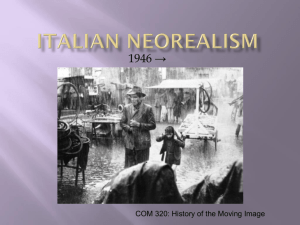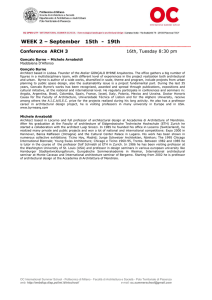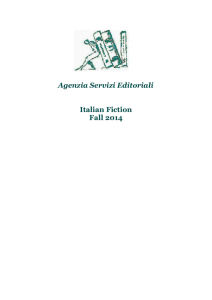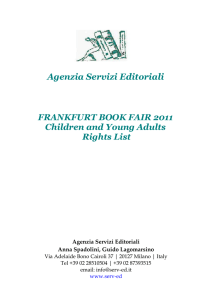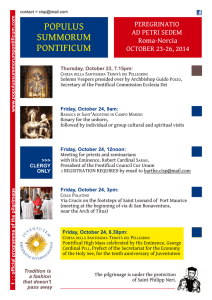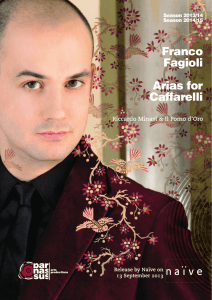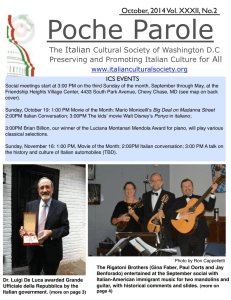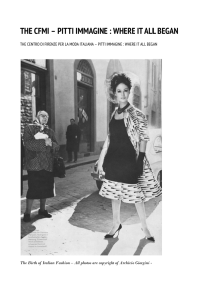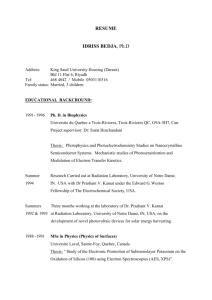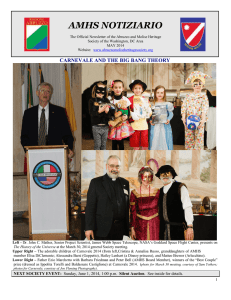Film History and Criticism lecture 3
advertisement
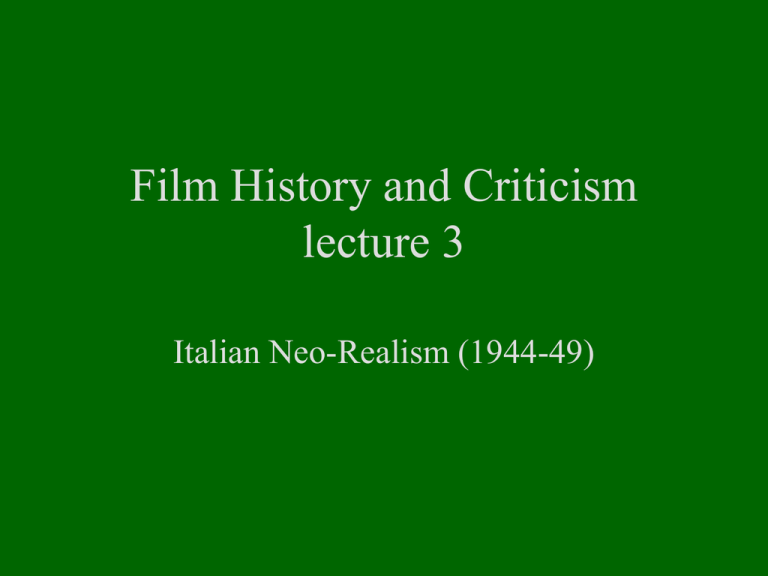
Film History and Criticism lecture 3 Italian Neo-Realism (1944-49) Week 3, January 22nd Italian Neorealism: Readings: Thompson & Bordwell Chapter 16 Neorealism and its Context pp.330-341 and Visconti, Rossellini Box, p338 Supplementary Readings: Hayward, S. Key Concepts: Italian NeoRealism pp.191-2. Corrigan, Timothy, White, Patricia, with Meta Mazaj, Critical Visions in Film Theory; Classical and Contemporary Readings Part 3 Modernism and Realism: Debates in Classical Film Theory. Andre Bazin “The Evolution of the Language of Cinema” pp 309-325 & Cesare Zavattini “Some ideas on the Cinema pp 915 -924 Screening: Rome, Open City (Roberto Rossellini dir. 1945) and clips from Miraculo a Milano (Miracle in Milan) (1950) and Ladri di Biciclette (Bicycle Thieves, 1948) dir. Vittorio De Sica. www.robertorossellini.it/ official site Introduction Key Questions: • When did it begin and end? • What were its sources? • Characteristics? • Was it new/neo? • How Italian was it? • How realistic? Responses 1. Term as a movement closely tied to the social-political situation in post-war Italy. Neo-realism coined by Italian Critic Umberto Barbaro. 2. French poetic realism Marcel Carne’s late films: Port of Shadows (1938) Daybreak (1939) and Jean Renoir, Rules of the Game (1939), and Grand Illusion (1937). 3. Characteristics of neo-Realism a) b) c) d) e) Location shooting Post-synchronized sound shooting Use of non-professional actors Not interested in entertainment A commitment to representation of social reality/actuality f) The narrative reflects actual duration g) Racked focus and long takes c.w. Renoir 4. Major Figures Roberto Rossellini (1906-1977) Rome Open City,(1945); Paisan (1946) , Germany Year Zero (1947). Vittorio De Sica (1902-1974) and Script writer Cersare Zavattini (1902-1989) Shoeshine, Bicycle Thieves, Miracle in Milan and Umberto D (1952) Luchiano Visconti (1906) Ossessione (Obsession 1942), The Earth Trembles (1948) Guiseppe de Santis (b1917) Riso Amaro (Bitter Rice 1949) Tragic Hunt (1948), No Peace for Under the Olives (1950) Characteristics continued 5. Was it New as the term Neo suggests – yes and no for the reasons cited earlier. 6. How Italian? Very, although there are also similar elements in earlier French cinema within poetic realist films. 7. How realist? With emphasis on location shooting more so than studio cinema. 8. To the Italian neo-Realists, reality and truth are not the same: reality (considered that which is possible to observe in everyday life) is the way to truth, and truth is the set of production relationships that rules society - the Marxist inspiration is evident here. Roberto Rossellini b. May 8, 1906, -d. June 3, 1977, Rome, Italy. “The father of neo-realism” • Biographical details: Roberto Rossellini was born in Rome May 8, 1906 the eldest son of a prominent Italian architect, had a younger brother named Renzo and sisters Marcela and Micaela. By all accounts Roberto lived a fairly stable life in a bourgeois – middle class home which enabled him to secure a good education and prospects for a career. General Guide to his films: 1) The Fascist period (1941-1944): Being 16 when Mussolini took power, Rossellini's formative period as a film maker was under fascism. He started his directorial career with three fascist propaganda features: La nave bianca (The White Ship) (1941) Un piloto ritorna (A Pilot Returns) (1942) L'uomo della crocce (The Man with the Cross) (1943) 2) Postwar trilogy (1945-1947): Only two years after his last fascist feature, Rossellini completed Roma, città aperta (1945), one of the most important - and immediate antifascist films, considered by many the beginning of Italian neo-Realism. This direction was emphasized in his following Paisà (1946) and Germania, anno zero (1947), is considered the most powerful anti-war film of his trilogy. Paisà1946 Germany Year Zero 1947 3) His 'Modern' film period (1949-1954): Stromboli (1949), a period is marked by his marriage to Ingrid Bergman and her participation in his work. 4.) Disenchantment (1957-1962): After his divorce from Ingrid Bergman, Rossellini traveled to India in 1957, where he completed a ten-part documentary series on 16mm. for Italian television and a 90-minute 35mm. feature. Later he began a four year period producing war films, and he also began exhibiting disenchantment with cinema. Cultural history (1964-1977): 5. In 1963, Rossellini abandoned cinema to work in television. He directed nine telefilms on historical subjects and six short documentaries, claiming TV could be used as an educational device. Near the end of these years, he completed two biographical features - Anno uno (1974), about Alcide de Gasperi, a Christian democrat politician and first postwar Italian president, and Il messiah (1975). Both were very badly received by Italian society, and Rossellini - who claimed they were within the realm of his history project pursued thus far on television - was accused of being reactionary and selling out. Rossellini's films are as much documentaries as they are fiction. Roma, città aperta (1945) is based on a narrative focusing upon three martyrs of the second world war. As Rossellini had few resources the film was shot on the actual locations, using different film stocks, in conditions that made lighting difficult, thus providing a documentary visual style. This, added to the colloquial dialogue, and very naturalistic acting, represented the core of this new "style" - Italian neo-Realism. The national and international success of the film earned Rossellini the title of "father of neo-Realism". Roma, città aperta differs from the neo-realist corpus (even from Rossellini's Paisà, his closest to neo-Realism) in significant ways. One of them, not the most important though, is the use of professional actors in the leading roles A few book titles for further research Bazin, André, Qu'est-ce que le cinéma? Paris, Editions du Cerf, 1962. Bergala, Alain (ed)., Le cinéma révélé. Paris, Editions de l'Etoile, 1984. Bergala, Alain et Narboni, Jean (eds.), Roberto Rossellini. Paris, Editions de l'Étoile/Cahiers du cinéma, 1990. Brunette, Peter, Roberto Rossellini. New York, Oxford University Press, 1987. www.robertorossellini.it/ Vittorio de Sica 1902- 1974 Began as an actor who starred in some 150 films. Over 50 years De Sica also directed 34 feature films, for which he won numerous international prizes. Four Academy Awards: two Special Awards, preceding the creation of the Best Foreign Film category, for Shoeshine (1947), and The Bicycle Thief in 1949, and Best Foreign Film Awards for Yesterday, Today and Tomorrow (1964), and The Garden of the Finzi-Continis in 1971. De Sica was born in 1902 in Sora, near Rome, grew up in Naples in a middle-class family. His father, Umberto a bank clerk with a love of show business, who encouraged his handsome son to pursue a stage career. De Sica first appeared at age 16 in the film The Clemenceau Affair and his career took off in the 1920s when he joined a local theater company and became a matinee idol. He later formed his own company, producing plays and co-starring with his first wife, Giuditta Rissone. Began making films during the war years. The first four films that he directed were routine light productions. The fifth, The Children Are Watching Us, has been described as a mature, perceptive, and deeply human work about the impact of adult folly on a child's innocent mind. This film marked the beginning of De Sica's important collaboration with author and screenwriter Cesare Zavattini, a creative relationship that was to give the world two of the most significant films of the Italian neo-realism movement, Shoeshine and The Bicycle Thief. Bicycle Thief (Ladri di biciclette). 1948 With no money available to produce his films, De Sica initiated the use of real locations and nonprofessional actors. Using available light and documentary effects, he explored the relationship between working and lower-class characters in an indifferent, and often hostile social and political environment. Vittorio De Sica died in 1974 at the age of 72. Luchino Visconti di Modrone, Count of Lonate Pozzolo Visconti Luchino Visconti di Modrone, of Lonate Pozzolo (November 2, 1906 - March 17, 1976) was an Italian theatre and cinema director and writer, best known for films such as The Leopard (1963) and Death in Venice. He died in Rome of a stroke at the age of 69. There is a museum dedicated to the director's work in Ischia. Visconti was born in Milan into a wealthy family (one of the richest of northern Italy). Visconti’s father was the Duke of Grazzano, and V. had six siblings. Visconti was exposed to high culture, to art, music and theater, and met some of the major Italian figures in each discipline, including the composer Giacomo Puccini, the conductor Arturo Toscanini, and the writer/poet Gabriele D'Annunzio. After World War II Visconti joined the Italian Communist Party. Together with Roberto Rossellini, Visconti joined the salotto of Vittorio Mussolini (the son of Dictator Benito Mussolini, who was during the fascist period the national arbitrator for cinema and other arts) and here presumably met also Federico Fellini. With Gianni Puccini, Antonio Pietrangeli and Giuseppe De Santis he wrote the screenplay for his first film as director: Ossessione (Obsession) (1943), the first neorealist movie and an adaptation of the novel The Postman Always Rings Twice. Visconti Neo -Realist Films Ossessione (1943, based on James M. Cain's 1934 novel The Postman Always Rings Twice) La Terra trema (1950) Bellissima (1951) Siamo donne (We, the Women) (1953) (episode Anna Magnani) Senso (Livia), 1954 Le notti bianche (White Nights), 1957 Rocco e i suoi fratelli (Rocco and His Brothers), 1960 Films continued Boccaccio '70 (1961, based on Boccaccio's Decameron). (episode Il lavoro) The Leopard (Il Gattopardo), 1963 - based on Giuseppe Tomasi di Lampedusa's novel Il Gattopardo) Vaghe stelle dell'Orsa (Sandra of a Thousand Delights), 1965) Vaghe stelle dell'Orsa (Sandra of a Thousand Delights), 1965) The Stranger (Lo straniero), 1967 - based on Albert Camus' novel L'Étranger) Le streghe (The Witches), 1967 (episode La strega bruciata viva) The Damned (film) (La caduta degli dei), 1969 (TV movie, 1970) Death in Venice (Morte a Venezia), 1971 Based on Thomas Mann's novel) Ludwig (1972) Conversation Piece (Gruppo di famiglia in un interno, 1974) L'Innocente (1976) Visconti Quote “I believe in life, that is the central point ... I believe in organized society. I think it has a chance”. Next week • Film Noir: Thompson & Bordwell (2nd edition) • pp 228, 233-235; and Chapter 17 pp 373-390. • Supplementary Readings: Leo Braudy “Genre: The Conventions of Connection” (613-629) • Screening: Scarlet Street (1945) Fritz Lang; The Big Sleep (1946) Howard Hawks; Rebel without a Cause (1955) Nicholas Ray.
